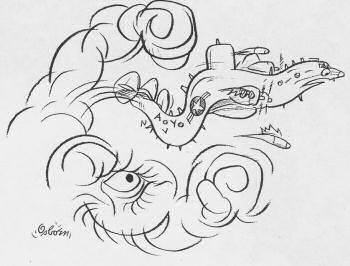The twenty-two Typhoon Hunters gathered at base ops at 1400 to be briefed on an assigned weather reconnaissance flight through tropical storm Judy. The crew had made an investigative flight through the same storm the day before and had found it small but growing.

The plan was to penetrate at low level (1,500 feet msl),then to make a climb-and-ascent sounding in the eye, escaping at the 700-millibar level (10,000 feet). The latest report (six hours prior) showed about 55-knot maximum winds. It looked like a routine flight.
The WC-121N Super Constellation lifted off from the Pacific island base at 1658. The storm was sighted at about 200-nm range. After a conference between the aircraft commander (AC), combat information center officer (CICO) and flight meteorologist (Metro) concerning the radar presentation and the characteristics of the storm, they decided to proceed with their previous plan.
At a distance of 70 miles, the AC took a last look at the radar and then took control of the aircraft.
The cabin was checked and the crew briefed. The wind and turbulence became more intense, so the power was increased to 2,600 rpm. The flight engineer was instructed to maintain 190 knots airspeed. Visibility in the darkness varied between zero to a half mile in and out of the clouds.
The CICO gave vectors to bring the aircraft to the storm eye. As they approached, Metro, observing winds of 80 to 90 knots, recommended heading changes to keep the wind off the port wing. At this time, the CICO's primary radar console failed, and it was necessary to move to the secondary scope which had not been set up as a back-up for the penetration. Reorientation of the scope, including a grease pencil sketch of the wall cloud, proceeded with some difficulty, owing to sea return and clutter, but it was accomplished in nine to 12 minutes. Metro visually observed the surface winds at an estimated 100 knots with a drift of over 30 degrees as they continued the search for the wind eye.
The heavy rain and turbulence continued until the surface wind velocity decreased. Shortly, the wind became completely calm, then almost immediately began increasing from the opposite direction. When the wind shifted, Metro recommended a 180-degree turn in whichever direction was best. CICO advised that he had heavy weather to starboard and called for a turn to port, then urged a hard port turn as the wall cloud became visible on the radar.
The pilot rolled the Willie Victor into a 20-degree-bank port turn and suddenly encountered the wall cloud turbulence. The first jolt caused the aircraft to vibrate so severly that the AC believed he was experiencing prestall shudder. Maximum power was ordered and set. As the aircraft rolled out on the escape heading, another shock of equal severity caused the airspeed to vary by 50 knots and altitude by 800 feet. The copilot came on the controls with the AC as the large craft became almost uncontrollable.
After about a minute, the turbulence and downpour subsided. The flight steadied down on heading for a climb to 10,000 feet. The third pilot was sent aft to check for injuries and damage.
Fortunately, no one was hurt. However, on his return to the cockpit, the third pilot observed blue sparks flashing in the vicinity of the starboard wing tip. When the over-wing lights were turned on, it was discovered that the starboard wingtip and the tip tank were missing.
The wingtip lights were secured and the other tip tank was emptied. No other difficulties were encountered, but the aircraft required five-degree right aileron and three-degree left rudder trim to maintain level flight. A normal landing was executed upon arrival at home base.

Brrr! Never underestimate the fury of a woman scorned! That wild young lady really gave those boys the brush-off. Though procedures were "standard through-out," I get the feelin' these boys may have become a little complacent and lacked adequate respect for a very unpredictable situation.
Loss of the radar left the flight literally gropin' in the dark for over ten minutes. Why wasn't the standby radar tuned up? Why was the flight seven knots over recommended turbulence penetration airspeed? Even a slight variation may become critical when you run into extreme conditions Ol' Gramps wants all the chips in his corner on a mission like this one.
